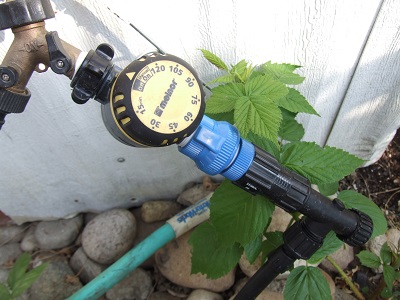I ordered a drip irrigation kit and the head assembly includes a backflow preventer, inline filter, pressure regulator, and hose adapter. I also purchased a timer. The problem is my hose adapter is only about 12 inches off the ground and I don't think everything will fit. Can someone tell me if this is a problem or if I'll be able to get some kind of short extension hose to make this work and just lay out the head assembly on the ground?
4 Answers
You might want to get a Y splitter like this...

Then mount all your equipment on a pole or board attached to the house or in the ground, and use a short length of hose to connect from the Y to the equipment. This would allow you to hook up all the equipment, while not losing the use of the hose bib.
I would probably avoid just setting the stuff on the ground, it would look much neater (and likely last longer) mounted in some way off the ground.
Don't connect to your "hose adapter". Instead take the time to properly plumb your irrigation system into your "domestic" cold water system.
My (very) limited in-ground sprinkler system knowledge is pretty much documented here on SE:
No 8. Don't connect your irrigation system to an outside tap (though this can be done, it's considered "poor practice"), instead properly plumb it into your "domestic" cold water system.
A little more work, but well worth taking the time and cost to-do.
When connecting into your "domestic" cold water system, install a "Backflow Device", this prevents water from your irrigation system entering your "domestic" cold water system. Such a device is "generally" required by local building codes and/or your local water company.
-
There’s nothing wrong with connecting simple drip system to a hose tap. If you building full blown in-ground system, then by all means, hook up to the water main. Otherwise, there’s no need for extensive plumbing to water some shrubs or vegetables. Besides, there are situations, where you would have to build above-ground system, such as on rental property, apartment, etc. Also, you can pack it up and move.– theUgCommented Aug 4, 2013 at 14:50
The basic main assembly would fit without modification. One of my assemblies even with Y-splitter is measured at 25 cm (10") vertically, and includes a timer, back-flow preventer, pressure regulator and a simple screen filter:

More elaborate set-up with a larger Y-filter, brass back-flow preventer, proportioner or other type of fertilizer injector may require more space indeed. Placing the whole assembly on the board to hang on the post or the wall and connect to it via short hose is a good idea, and it can be easily taken off as a whole for storage, but it can have its drawbacks, as it can be considered unsightly, and is exposed to the sun damage.
Another option is to place it at or below the ground level for concealment. Below are two illustrations from 1992 edition of Robert Kourik’s Drip Irrigation for Every Landscape and All Climates that show the main assembly set-ups below the ground in the box, and above the ground. For above the ground option author recommends letting the ground cover grow around it for protection and concealment (keep in mind the ability to remove it for winter storage — don’t let vines tangle it all up). Likewise, the box can be placed above the ground as well.
The illustrations present more professional assemblies cutting into water supply, and generally a little convoluted and complicated-looking (keep in mind, the book is also over 20 years old), but the basic principle applies for a simpler modern assembly, and the short length of hose from the bib can also be used to route into the box or to the ground level.


Lastly, important point to consider is that simple plastic atmospheric back-flow preventer may not work correctly if placed too low in relation to the rest of the system (some recommend 30 cm (12") above the highest point in the system), so you could screw it onto the bib itself before the length of hose, or use more expensive brass-type preventer and check-valve combination (check the local building codes for requirements — generally, check-valve alone is not enough) to place closer to the ground.
You can get short garden hoses anywhere from 6' to 15' in length. They also make shorter lengths about 6" long that are usually sold as "Kink Protectors".
